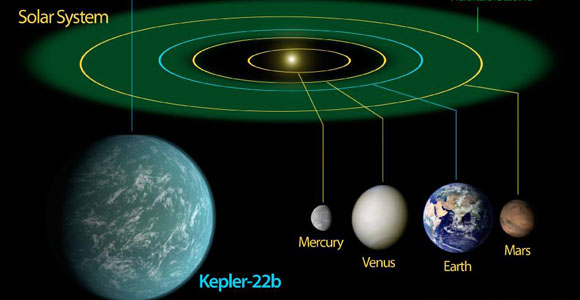Has NASA’s Kepler Mission Found Our Earth 2?
It Came From Outer Space

In 2009, NASA launched the Kepler spacecraft in order to find Earth-like planets orbiting other stars in the Milky Way galaxy. Well, the results are now in and I’ve got goosebumps just thinking about it.
And the verdict is…good! “NASA’s Kepler mission has confirmed its first planet in the ‘habitable zone,’ the region where liquid water could exist on a planet’s surface,” they write on their site. “Kepler also has discovered more than 1,000 new planet candidates, nearly doubling its previously known count. Ten of these candidates are near-Earth-size and orbit in the habitable zone of their host star. Candidates require follow-up observations to verify they are actual planets.”
The habitable planet has been dubbed Kepler-22b (I dubbed it Kittenland but whatever) is about 2.4 times the radius of Earth but scientists need further study to find out what kind of surface it has. You may remember, NASA recently found Kepler-16b, which has two suns leading many geeks to make comparisons with Tattooine and/or Galifrey. With the discovery of Kepler-22b, I think it’s time to call up Earth 2 on Netflix instant watch.
“This is a major milestone on the road to finding Earth’s twin,” said Douglas Hudgins, Kepler program scientist at NASA Headquarters in Washington. “Kepler’s results continue to demonstrate the importance of NASA’s science missions, which aim to answer some of the biggest questions about our place in the universe.”
Kepler, named for the 17th-century German astronomer Johannes Kepler, pulls candidates by “measuring dips in the brightness of more than 150,000 stars to search for planets that cross in front, or ‘transit, the stars” and requires three transits before it will confirm a planet.
“Fortune smiled upon us with the detection of this planet,” said William Borucki, Kepler principal investigator at NASA Ames Research Center at Moffett Field, Calif., who led the team that discovered Kepler-22b. “The first transit was captured just three days after we declared the spacecraft operationally ready. We witnessed the defining third transit over the 2010 holiday season.”
Kepler-22b is 600 light-years away and has a 290 day orbit around its sun. That sun is slightly smaller and cooler than our own but still G-type but Kepler-22b is only the first in what is likely to be many more confirmations of possible habitable planets.
“The Kepler team is hosting its inaugural science conference at Ames Dec. 5-9, announcing 1,094 new planet candidate discoveries,” says NASA. “Since the last catalog was released in February, the number of planet candidates identified by Kepler has increased by 89 percent and now totals 2,326. Of these, 207 are approximately Earth-size, 680 are super Earth-size, 1,181 are Neptune-size, 203 are Jupiter-size and 55 are larger than Jupiter.”
“The tremendous growth in the number of Earth-size candidates tells us that we’re honing in on the planets Kepler was designed to detect: those that are not only Earth-size, but also are potentially habitable,” said Natalie Batalha, Kepler deputy science team lead at San Jose State University in San Jose, Calif. “The more data we collect, the keener our eye for finding the smallest planets out at longer orbital periods.”
(via NASA)
Have a tip we should know? tips@themarysue.com